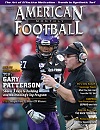Article CategoriesAFM Magazine
|
Secrets of Central Florida’s Elite Kickoff Unitsby: David Purdum© More from this issue UCF had the best combined kickoff return and coverage statistics in the FBS. Central Florida’s elite kickoff units aren’t built exclusively with elite athletes. In fact, when building the coverage and return units, physical traits like speed, strength and size often take a backseat to effort, attitude and toughness. The formula works. Special teams coordinator Tim Salem’s kickoff return team finished No. 1 in the nation, averaging 27.78 yards per return with two touchdowns. The Knights were nearly as good on kickoff coverage. They finished third in return defense, allowing a measly 17.48 yards. Those numbers are even more impressive when you consider UCF’s coverage unit benefited from only four touchbacks. No other top-5 kickoff coverage unit had to defend more tha....The full article can only be seen by subscribers.
|
|
|||||||
| HOME |
MAGAZINE |
SUBSCRIBE | ONLINE COLUMNISTS | COACHING VIDEOS |
Copyright 2025, AmericanFootballMonthly.com
All Rights Reserved





